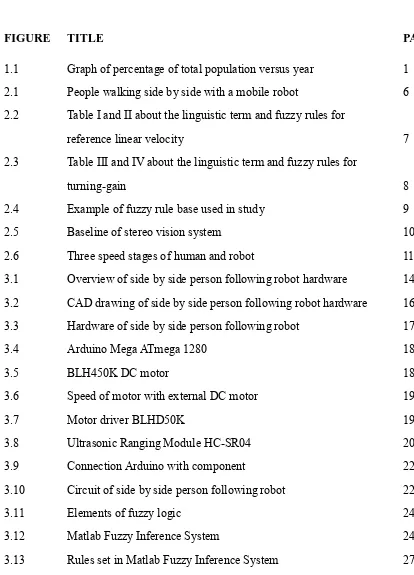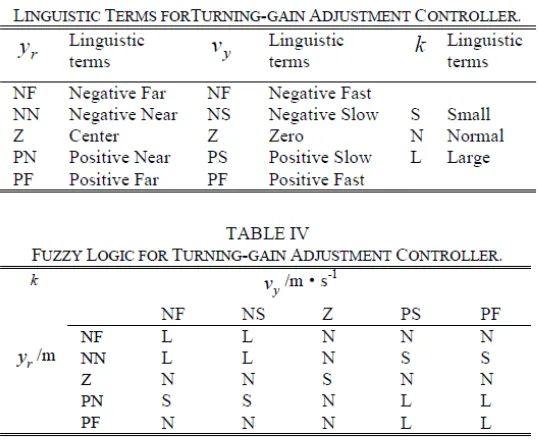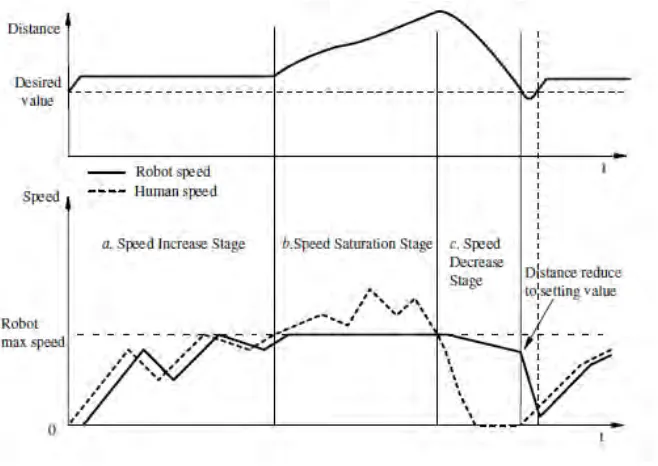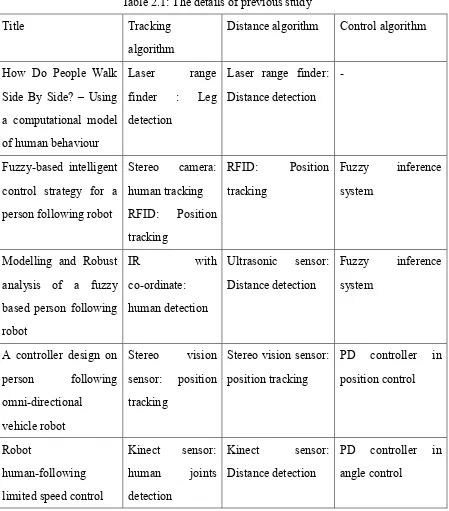SIDE BY SIDE SPEED AND DISTANCE CONTROL FOR PERSON FOLLOWING ROBOT
TEOH YEW CHONG
A report is submitted in partial fulfillment of the requirement for the Bachelor of Mechatronic Engineering
Faculty of Electrical Engineering
UNIVERSITY TEKNIKAL MALAYSIA MELAKA
I declare that this report entitle “Side by Side Speed and Distance Control Person Following Robot” is the result of my own research except as cited in the references. The report has not been accepted for any degree and is not concurrently submitted in candidature of any other degree.
Signature : ………
Name : ………
i
Acknowledgement
Abstract
iii
Abstrak
TABLE OF CONTENTS
CHAPTER TITLE PAGE
ACKNOWLEDGEMENT i
ABSTRACT ii
ABSTRAK iii
TABLES OF CONTENTS iv
LIST OF TABLES vi
LIST OF FIGURES vii
LIST OF ABBREVIATIONS ix
LIST OF APPENDICES x
1 INTRODUCTION 1
1.1 Motivation 1
1.2 Problem Statement 2
1.3 Objective 3
1.4 Scope 3
2 LITERATURE REVIEW 5
2.1 Introduction 5
2.2 Review on Previous Study of Person Following Robot 5
2.2.1 Comparison 12
2.2.2 Summary 13
3 METHODOLOGY 14
3.1 Introduction 14
3.2 General Overview of Hardware 14
3.3 Material 17
3.3.1 Arduino Mega ATMega 1280 17
v
3.3.3 Motor Driver BLHD50K 19
3.3.4 Ultrasonic Sensor 20
3.4 Circuit 22
3.5 Software 23
3.6 Fuzzy Logic 24
3.6.1 Input 24
3.6.2 Output 25
3.6.3 Fuzzy Rules 26
3.7 Overview of Side by Side Following Robot 28 3.7.1 Flowchart of Program of Side by Side
Person Following Robot 28
3.7.2 Block Diagram 29
3.8 Project Setup 30
3.4.1 Experiment 1 30
3.4.2 Experiment 2 32
4 RESULT AND ANALYSIS 35
4.1 Overview 35
4.2 Experiment 1 35
4.2.1 Analysis of Data 38
4.3 Experiment 2 40
4.3.1 Analysis of Data 44
5 CONCLUSION 47
5.1 Conclusion 47
5.2 Recommendation 47
REFERENCES 49
LIST OF TABLES
TABLE TITLE PAGE
2.1 The details of previous study 12
3.1 Other material in hardware 20
vii
LIST OF FIGURES
FIGURE TITLE PAGE
1.1 Graph of percentage of total population versus year 1 2.1 People walking side by side with a mobile robot 6 2.2 Table I and II about the linguistic term and fuzzy rules for
reference linear velocity 7
2.3 Table III and IV about the linguistic term and fuzzy rules for
turning-gain 8
2.4 Example of fuzzy rule base used in study 9
2.5 Baseline of stereo vision system 10
2.6 Three speed stages of human and robot 11 3.1 Overview of side by side person following robot hardware 14 3.2 CAD drawing of side by side person following robot hardware 16 3.3 Hardware of side by side person following robot 17
3.4 Arduino Mega ATmega 1280 18
3.5 BLH450K DC motor 18
3.6 Speed of motor with external DC motor 19
3.7 Motor driver BLHD50K 19
3.8 Ultrasonic Ranging Module HC-SR04 20
3.9 Connection Arduino with component 22
3.10 Circuit of side by side person following robot 22
3.11 Elements of fuzzy logic 24
3.12 Matlab Fuzzy Inference System 24
[image:9.595.81.495.170.745.2]FIGURE TITLE PAGE 3.14 Flowchart of side by side person following robot distance
control system 28
3.15 Block diagram of side by side person following robot 29 3.16 The circuit of brushless DC motor with motor driver and Arduino 31 3.17 Schematic circuit of brushless DC motor 31
3.18 Experiment 2 Setup 32
3.19 Location of hardware in a room 33
3.20 Experiment 2 setup and hardware tested in a room 33 4.1 First reading of RPM versus Duty cycle 34 4.2 Second reading of RPM versus Duty cycle 35 4.3 Third reading of RPM versus Duty cycle 35 4.4 Fourth reading of RPM versus Duty cycle 36 4.5 Fifth reading of RPM versus Duty cycle 36 4.6 Sixth reading of RPM versus Duty cycle 37 4.7 Average reading of RPM versus Duty cycle 37
4.8 Distance from front sensor versus RPM 39
4.9 Distance from back sensor versus RPM 39
4.10 Overshoot in graph of distance versus RPM 40
ix
LIST OF ABBREVIATIONS
LIST OF APPENDICES
APPENDIX TITLE PAGE
A Grantt Chart 50
B Programming for experiment of motor speed control 51
C Programming of experiment 2 53
1
CHAPTER 1
INTRODUCTION
1.1 Motivation
[image:13.595.76.556.481.720.2]Nowadays, assistive robot is widely developed to assist human in daily life such as use to help patient in hospital or elderly in home nursing. But if the assistive robot can have interacted with human, the robot can assist human more effectively [1]. Besides, assistive robot also is introduced by Japan government for the purpose of assist elderly in daily life, it is due to from the World Bank population aging research Japan has a highest percentage of aging of total population (25%) compare to other country [2] [3]. Moreover, in Malaysia the data show 1.5 million Malaysian are elderly.
Figure 1.1: Graph of percentage of total population versus year Percentage of total
population (%)
Person following robot is one of the assistive robot which can follow and assist human. There are 2 types of person following robot; first type is robot following behind human and second type is side by side person following robot. Robot following behind human has the most researches compare to side by side person following robot. But robot following behind human has less interacted with human due to this robot only follow at behind of human and when human walking, human does not know the status of robot whether it is follow or not. So, side by side person following robot is most suitable due to it is following target human beside him/her has more interact with human.
This type of robot can widely develop in many applications such as factories, office and supermarket. Side by side person following robot can be used in office, work as an assistant of human help them record and remind human. Besides, side by side person following robot also can use in the field of tourism such as guide human walking to reach their destination. Furthermore, side by side person following robot as an assistive robot can use as home nursing robot. [4]
1.2 Problem statement
From the previous researches, most only focus on the robot following behind a human, however it seems not much advantage for human since human and robot less interact at all. So to let human and robot have interacted is to design the robot side by side following a human. Then both human and robot can get information from each other easily.
3
When a side by side person following robot is following a target human, the robot must able to measure distance, d between robot and human. In order to to control speed of robot, a suitable control algorithm is needed with inputs signal from distance sensor, so that output is the speed of both motors, vm, can be adjusted according the sensors signal.
For example, if target is far around 150cm from robot, the robot can speed up due to target may walk away from the view of distance sensor. If the target is near around 50cm from robot, the robot may using medium speed to follow human.
1.3 Objective of Project
There are three objectives in this project.
i. To develop prototype of a side by side person following robot
ii. To design control algorithm for a side by side person following robot that has speed control.
iii. To analysis the performance of developed side by side person following robot in term of speed and distance control.
1.4 Scope
The scopes of this project are outlines as follows.
1. From this project is to design a side by side person following robot which able to measure distance between human when following human and able to control the speed to follow human.
2. Besides, the path of human walking is straight line only when followed by side by side person following robot.
5
CHAPTER 2
LITERATURE REVIEW
2.1 Introduction
Person following robot is a famous research due to it is very useful in assist human future life. The information from the previous research is use as guide to build a better side by side person following robot in this project. This chapter is about review, comparison and summary of previous researches on person following robot.
2.2 Review on previous study of person following robot
A study about side by side person following robot with the objective of able to follow beside target person and can keep a safe distance between target person and robot when both robot and human are moving. In this study, laser range finder with the detection range of 30m is used to detect target human. One unit of laser range finder can cover 180 degree of field of view, so two units laser range finder will built inside the robot which can cover 360 degree means it can detect surrounding of robot. Eight parameters are considered to design a better person following robot such as social relative distance, relative angle, relative velocity, distance to obstacle, sub goal, velocity, angular velocity and acceleration [5].
self-anticipation. This method is use to plan the next step of robot movement to enlarge its utility with preferred linear velocity, angular velocity and acceleration. After these two methods the next method is the partner and self-anticipation. It plans next step movement of robot to maximize robot utility and target utility. There are few shortcomings in the study [5] such as parameters are not systematically calibrate, standard prediction method and the self-anticipation have the problem of lacks of ability to make the robot take a lead toward the target. Figure 2.1 is shows a success side by side person following robot by considering eight parameters [5].
Figure 2.1: People walking side by side with a mobile robot Source:[5]
7
tracking part is obtained and from these two to do adjustment for turning gain and linear velocity. Then, the turning gain is adjusted online to make sure the target is in the view of camera, as the direction between target and robot is increased the turning gain is also increased while turning radius is decreased. There are two main parts using fuzzy based controller to control the motion of person following robot; reference linear velocity and turning-gain.
Furthermore, in order to get the reference linear velocity, vre, two inputs is considered
and there are the distance, xr, between target and robot when both are moving and the
vertical velocity of target, vx. The rules between distance, xr, and vertical velocity of target,
vx to get reference linear velocity is shown in Figure 2.2 with linguistic term. For example,
if the distance, xr, is very near (VN) and the vertical velocity of target, vx is very slow (VS),
[image:19.595.167.463.395.661.2]then reference linear velocity, vre is very slow (VS) [6].
Figure 2.2: Table I and II about linguistic term and fuzzy rules for reference linear velocity Source:[6]
target, vy will considered as inputs to obtain output turning-gain of robot, k. The rules used
to obtain turning-gain, k is shown in Figure 2.3. The example of the rules is if the absolute direction, yr is negative far (NF) and velocity of target, vy is negative slow (NS), and then
[image:20.595.172.441.225.445.2]the output turning-gain, k is large [6].
Figure 2.3: Table III and IV about linguistic term and fuzzy rules for turning-gain Source:[6]
9
Figure 2.4: Example of fuzzy rule based used in the study Source:[7]
From those rules the person following robot is tested in three conditions such as target in centre location of robot, target is in left side of robot and target is in right side of target. At the first conditions, the robot able to follow up human speeds with full power and can keep a safe distance with target. Besides, the robot able to make a curve turn to follow target by controlling left and right motor in the next two conditions [7].
Furthermore, a study about person following Omni-directional vehicle robot is focus more on position of the target. So input of position controller is based on 2 stereo camera sensors and reference position which is XR, YR and ZR. Typically there are two methods of
Figure 2.5: Baseline of stereo vision system Source:[8]
The speed control of person following robot is mention in [9]. Speed control of this study is set according to three conditions such as death zone, speed control and adaptive deceleration. Death zone is a zone of errors occurs in robot like the distance control is different from the desired value. This is very important due to error is needed to consider building a better side by side person following robot. Furthermore, speed control is same as death zone where it also considered the response time of robot speed up and motion robot is slower than human walking speed. At the same time, adaptive deceleration algorithm is also considered depends on the speed decrease stage.
Three speed stages was introduced in the paper [9] and there are speed increase stage, speed saturation stage and speed decrease stage. These three stages are about the categories of robot speed and robot speed will changed according the output signal from the Kinect sensor. In order to find the error of human relative angle, PD controllers is used and apply on the servo motors control of robot. After the person following robot is done, few experiments is needed to test;
1. Target human move forward and reverse only for examining speed control. 2. Target human turn around the robot with constant distance is for testing angle
control.
11
testing.
[image:23.595.142.471.142.375.2]4. Forward and reverse path.
2.2.1 Comparison of previous study
Table 2.1: The details of previous study
Title Tracking
algorithm
Distance algorithm Control algorithm
How Do People Walk Side By Side? – Using a computational model of human behaviour
Laser range finder : Leg detection
Laser range finder: Distance detection
-
Fuzzy-based intelligent control strategy for a person following robot
Stereo camera: human tracking RFID: Position tracking
RFID: Position tracking
Fuzzy inference system
Modelling and Robust analysis of a fuzzy based person following robot
IR with
co-ordinate: human detection
Ultrasonic sensor: Distance detection
Fuzzy inference system
A controller design on person following omni-directional
vehicle robot
Stereo vision sensor: position tracking
Stereo vision sensor: position tracking
PD controller in position control
Robot
human-following limited speed control
Kinect sensor: human joints detection
Kinect sensor: Distance detection







